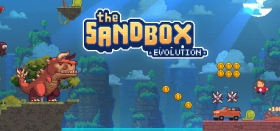The Sandbox Evolution Review
Physics in games have always fascinated me, from games made in Flash to people going all ragdoll in AAA titles. It was this that brought The Sandbox to my attention, back when it was a mobile-only title. I had played similar games before, but never on the same scale, and rarely with actual levels to play -- they were literally sandboxes.
In the original, you had a bunch of elements which interacted with each other in certain ways -- oil would burn, rock would melt under enough heat, ice could melt, electricity activated circuits… It even came to Steam, where I bought it (the mobile version was free, with paid DLC [which I also bought]), as it was enhanced with more elements to have fun with. As I mentioned, there were levels with puzzles to solve, as well as the ability to just create a little area with trees and maybe a lake… and then torch it whilst laughing maniacally.
![]()
The main letdown with The Sandbox was that it all took place on one screen. You could zoom in, but your space was limited. That’s where The Sandbox Evolution comes in, with scrollable levels as well as a few new elements and much nicer graphics. The original had nice sprites, but now they are lovely sprites.
Everything reacts how you would expect - lava boils water and melts ice, electricity sets off C4 but not TNT… The effects used are a huge improvement, with some nice particle bursts and lighting.
![]()
You don’t have to touch the campaign mode if you don’t want to, and honestly The Sandbox never really wanted you to play them. They want to make it seem more important to make your own levels, rather than have that as a secondary feature. Create is the main mode, as shown by the size of its button, and the fact it’s at the top of the menu.
It’s fairly simple to create a world, which can be anything you like. Make anything from a brain teasing puzzle to a Mario Maker-beating platformer level. There are multiple characters to choose to control if you go for the latter - a ninja, a soldier, a hamster… Each does something different such as double jump or fire a machine gun, so you can tailor your level however you want.
![]()
You will have to eventually go into the Play mode, which is the loose definition of campaign, has pre-built levels to show you the basics of what everything can do. Completing them gives you mana points, which you spend on unlocking new elements and materials in Create. There are nine worlds to complete, which show off everything from drawing a curved pixel line to building a battery with acid.
You can also get mana simply by playing the game once per day, as well as completing daily quests. These are found under the Quest tab, and give you three levels picked from the many available player-built levels.
![]()
The final option is Worlds, which shows all of the levels created by other players. Much like any game with level creation, there are some duds and some amazing. I found that it was mostly pixel art and side scrolling, with only a few ‘experiments’, leaving me having to conduct those on my own in Create.
There does appear to be an annoying bug with the list population in Worlds, where you will exit a level after playing it, only to find the list now empty. It can take a few minutes to pop back up, or it might just tell you that you’ve lost your internet connection, which needs you to restart the game.
The Sandbox Evolution is a big improvement on The Sandbox. It has plenty to do, and it’s (usually) easy to find something interesting made by the creative player base. It’s not for everyone because a lot of the longevity relies on you creating your own levels, but there is plenty to play with, thanks to the community created levels.
The Sandbox Evolution (Reviewed on Windows)
This game is great, with minimal or no negatives.
It has plenty to do, and it’s (usually) easy to find something interesting made by the creative player base. It’s not for everyone because a lot of the longevity relies on you creating your own levels, but there is plenty to play with, thanks to the community created levels.








COMMENTS